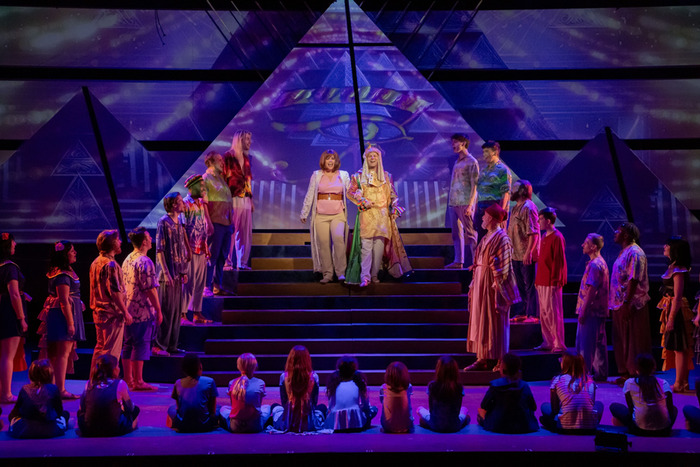
My first exposure to Joseph & the Amazing Technicolor Dreamcoat was ironically at Beck Center, where I recently saw their newest edition of that play. That show many years ago starred Rob Gibbs, now a local director and actor It was a fine introduction to Andrew Lloyd Webber and Tim Rice’s musical, which had an unusual path to being one of the oft-produced musicals of all time. It has been estimated that worldwide, over 20,000 school, community and professional theaters have produced the work.
As its creation story goes, in 1967, when Webber was 19 years old, he was asked to write a pop cantata for the school choir to sing at their Easter end-of-term concert. He asked his friend Tim Rice to write lyrics for the project. They decided to base the work on the story of Joseph from the Biblical book of Genesis.
Joseph started as a twenty-minute choral piece. The show gradually developed into what is now a full script. It is, however, a different type of script than most musicals. In fact, it is not a script at all, just a collection of 20 songs arranged in chronological order, with no narrative and no stage directions. This is why each production of the show takes on a different approach. Sometimes the presentation is done in two acts, sometimes in one. It has been staged as a bedtime story in pajamas, a Biblical epic complete with clothing of the time of Jacob, a fantasy costumed in out-of-this world clothing, and with and without a chorus.
The Narrator explains, in the “Prologue,” that this is a tale of Joseph, whose clairvoyant powers, intelligence and charm lead to both his being his father’s favorite and the wrath of his 11 brothers (“Jacob and Sons”). The envy increases when Jacob gives Joseph, a symbol of respect (“Joseph’s Coat”). His “bros” get rid of him by planning fratricide, but change their minds and sell him to some passing Ishmaelites (“Poor, Poor Joseph”), who take him to Egypt. They explain his “death” to their father in “One More Angel in Heaven.”
Joseph eventually becomes the Pharaoh’s favorite when he successfully enciphers the leader’s nightmares (“Pharaoh’s Dreams Explained”), saves Egypt from famine, becomes the second in command, eventually forgives his brothers when they come to beg for food (“Grovel/Grovel”) and, in an emotional climax, reunites with his father (“Jacob in Egypt” — the song tells us “And Joseph came to meet him/In his chariot of gold” — not a chariot in site!). The play concludes with the audience on its feet clapping as the cast sings “Any Dream Will Do” and “Give Me My Colored Coat”.
Like many of Andrew Lloyd Webber conceptions, which includes Cats, Jesus Christ Superstar, Evita and Phantom of the Opera, much of the music is infectious. There are parodies of French ballads (“Those Canaan Days”), rock and roll (“Song of the King”), western (“One More Angel In Heaven”), 1920s Charleston (“Potiphar”), Calypso (“Benjamin Calypso”), and go-go music (“Go, Go, Go Joseph”). Lyricist Tim Rice, Webber’s longtime collaborator, not only has written for Broadway, but for such Disney films as Aladdin, Beauty and the Beast and The Lion King.
Broadway Tony nominee, Mary Bridget Davies, the Narrator, has a fine voice and the ability to sing meanings, not just words. Her “Prologue” set a perfect tone to start the show and introduced us to the story and let the chorus of kids enter. Jess Markowitz has a pleasant voice and stage presence, but misses the undefinable special quality that makes Joseph into a charmer. His “Close Every Door” was nicely interpreted and sung.
Jimmy Helms does an Elvis-light interpretation in “Song of the King.” Maybe not wearing a traditional Elvis white body-hugging jumpsuit was issue. But more relevant were directorial decisions. As in other parts of the show, the words being sung are ignored as clues to the visuals being created on stage, so the audience is left with conflict between what they are hearing and what they are seeing.
The children’s chorus is excellent in both their vocal abilities, staying in character and reacting appropriately throughout. All of the brothers do a nice job of creating individual different personalities into their characterizations, and nicely singing solos and choral sounds.
Lauren Tidmore’s choreography was creatively and well interpreted, fitting the changing moods of the music into the style of each segment of the show. Brittany Merenda’s projections enhanced the liveliness and visual aspects.
The musicians did a nice job of supporting, rather than drowning out the performers, especially in the solos. Some of the musical arrangements, which changed the intent of some songs might be questioned by Joseph traditionalists.
Capsule judgment: Joseph and The Amazing Technicolor Dreamcoat is a fun show for audiences of all ages. As evidenced by the extended applause at the end of the show, and the many instances of audience delight displayed during the production, despite some questionable directorial decisions, the cast and crew’s efforts were appreciated.
Joseph and the Technicolor Dreamcoat runs through December 30 at Beck Center for the Arts. For tickets call 216-521-2540 or go to beckcenter.org.
[Written by Roy Berko, member: American Theatre Critics Association, Cleveland Critics Circle]